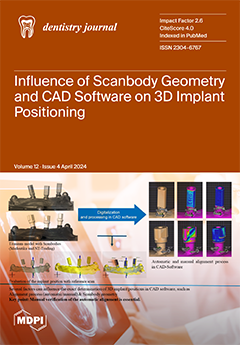Soft drinks may have a deleterious effect on dental health due to a high titratable acidity and a low pH that could be sufficient to induce tooth demineralization. The use of oral care products immediately after acidic challenge may diminish the erosive potential of soft drinks. We assessed the effect of oral care foams and a spray on salivary pH changes after exposure to Coca-Cola
® in young adults. Thirty-three consenting eligible patients were recruited in this double-blind, randomized, crossover study performed in six visits. Baseline examination included unstimulated salivary flow rate, stimulated salivary buffer capacity, and the simplified oral hygiene index (OHI-S) assessment. Salivary pH and time for pH recovery were registered after exposure to Coca-Cola
® alone or that followed by the application of each of the studied products (an oral foam containing hydroxyapatite and probiotics, an oral foam containing amino fluoride, an alkaline oral spray, and tap water). Thirty-two patients completed the entire study protocol and were included in the final analysis. The mean minimum salivary pH and the mean oral clearance rate after rinsing with Coca-Cola
® were 6.3 and 27 min, respectively. Further rinsing with any one of the tested solutions, including tap water, resulted in a significant improvement in these parameters. When the pH curves were plotted, the oral care products demonstrated a lower area under the curve that differed significantly from the area under the curve for Coca-Cola
®; tap water did not differ significantly from Coca-Cola
® and oral care products. Minimum salivary pH correlated positively with salivary buffer capacity and salivation rate, while salivary clearance correlated with OHI-S plaque scores. In conclusion, the effect of oral care foams and a spray on minimum salivary pH and salivary clearance after exposure to Coca-Cola
® did not differ significantly among the tested products and tap water. Trial registration NCT06148662. Funding: none.
Full article






